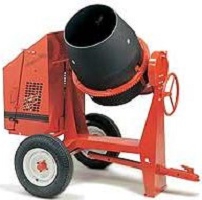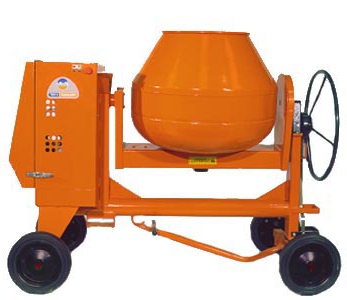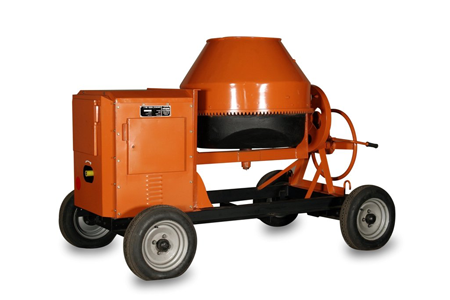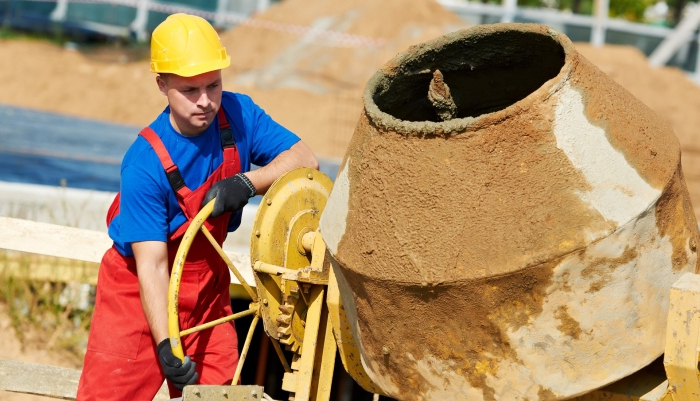The construction of any object, regardless of its number of storeys, location and purpose, requires a constant supply of the finished solution. For a long time, concrete has not been made manually directly at the construction site.
Now this task has passed into the duties of special devices - concrete mixers. If the buyer has decided to purchase such a device, then he may be concerned about the question of which concrete mixer to choose. Next will be talked about this.
Choosing a concrete mixer
 This is truly an indispensable tool for those who decide to seriously engage in building a house or renovating.
This is truly an indispensable tool for those who decide to seriously engage in building a house or renovating.
This device mixes cement with water and all kinds of mixtures, which allows to obtain mortars.
For any construction equipment, the basic requirement is presented - it must be of high quality, since speed, efficiency and quality of work, as well as the final result, depend on this.
Concrete Mixer Groups
If you have thoroughly decided to buy a concrete mixer, you should be aware of the division of all devices of this category into two large groups: periodic and continuous. When choosing equipment for yourself, it is best to start with this classification. If you need a mixer, the task of which is to knead the mortar for a small construction object or for small construction work, then the acquisition of a batch device is optimal.
Such a concrete mixer can be started and stopped at any time, as soon as it is required to select the finished solution in whole or in part. The continuous mixer is characterized by its large size and sophisticated design, as well as its higher cost. It is more appropriate to purchase it for large construction projects, since it allows you to get large volumes of mortar.
Features of the unit and its varieties
This device is a device with which you can get a homogeneous concrete mixture by mixing its components in a special purpose tank. The concrete mixer has a rather simple device, which requires a metal frame, a steel double-cone drum, in which special blades are placed, as well as a tipping mechanism, a control panel and an electric motor. Concrete mixer and mortar mixer are two devices that differ in the ability to work with filler of different fractions: in the first version 20-70 mm are allowed, and in the second - not more than 20 mm.
If you decide on which concrete mixer to choose, then you need to know about the classification features of these devices.
The method of mixing the solution
The first type of concrete mixer works by the gravitational principle. In this case, it is understood that the drum rotates, in which the blades are fixed motionless. Such a device serves as a universal device, in which it is possible to prepare not only light, but also heavy concrete mixtures.
In the second type, the drum remains stationary, and the blades rotate inside it. By the type of work, it all resembles an ordinary kitchen mixer. If we talk about how to choose a concrete mixer, then it is worth noting that this option is completely unsuitable for working with a filler of a large fraction. It requires a powerful electric drive, and this immediately becomes noticeable in electricity consumption. A similar option is actively used for domestic needs during the "big" construction.With the help of such a concrete mixer, light mortars are used, which are used for pouring floors or plastering walls.

type of drive
Another important point when choosing a concrete mixer is the type of drive used to operate it.
The first can be called an electric concrete mixer, which is equipped with an engine, whose work is carried out from the electric network. Such installations can use one of two variants of the mechanism for transmitting torque to the drum from the engine. The gearbox assumes that the movement of the rotor of the electric motor will be converted into rotation of the drum with low speeds. This option is reliable to use, and it creates very little noise.
The crown principle implies that on the outside of the drum there is a crown with teeth made of polyurethane or cast iron. This mechanism involves the transmission of movement to the crown, which uses the drum. This option requires the owner to frequently clean the crown or replace it, since cement and sand constantly get on it, which leads to rapid wear. Such a concrete mixer is very simple in terms of operation, and its repair does not seem difficult.
There are mechanical concrete mixers, which include parts similar to the first embodiment, only in this case there is no electric motor and control panel. The rotation of the drum or the blades inside it is provided by a special lever. A similar option is relevant for those places where there is no opportunity to connect to the electrical network. Such a concrete mixer has the advantage of reliability and low cost, but in terms of operation it requires a lot of time and effort.

There should be no errors with the choice
When it comes to how to choose a concrete mixer, you need to remember a number of significant points:
· The volume of the drum. At the moment, you can find installations whose mixing tanks are designed for a volume of 50-200 liters, but it should be noted that the yield of the finished mixture is 10-15% of the total weight of the components placed in the drum. If we talk about how to choose a concrete mixer for giving, then here the best option would be a device with a capacity of 100-150 liters.
· Steel of various thicknesses is used to make the drum casing. Since erosion of metal begins due to constant contact with cement, gravel and water, it is recommended to opt for a product whose wall thickness is 1 mm or more. This option will serve you for more than one year.
· Engine power. The work of domestic installations is carried out from a conventional electric network with a voltage of 220 volts, and the power of their engine is not more than one kilowatt. There are units and more powerful ones, which are designed for a network with a voltage of 380 volts. Small construction on a summer cottage can be implemented with a 0.7 kW device.
· Motor protection. Typically, concrete mixtures are made outdoors. That is why it is important to take into account such a parameter as the quality of engine protection against the ingress of foreign objects or liquids.
· Availability of a steam generator. This option assumes that you want to use the device at temperatures below +2 degrees Celsius.
Exploitation
If you already understand everything about how to choose a concrete mixer, then you should figure out how to operate it correctly. During operation, you must strictly adhere to the rules specified in the instructions for the unit. Before starting work, you should check the build quality at idle, which will make sure that it is working. Materials are loaded in a certain sequence: first water, and then cement, sand, gravel and other fillers. The materials are mixed for 1-3 minutes until a uniform consistency is obtained. Stirring for more than three minutes sometimes negatively affects the quality of the resulting solution.
It is important to understand that a concrete mixer is a seasonal appliance, therefore it can be used from spring to autumn, when the air temperature does not drop below +3 degrees Celsius. Do not use it at lower temperatures.
Care
If we are talking about the option with a gear wheel, then it should not be lubricated with any lubricants, as this can cause the sticking of abrasive particles, because of which the product will quickly fail. If it is assumed that work is being done with an electric concrete mixer, then its connection to the network should be carried out using a special plug, cable and socket. Usually this is an euro cable, similar to that used on washing machines and lawn mowers. Otherwise, the electromagnetic starter may continuously knock out due to current fluctuations.

What can not be done?
So, you already know how to choose the right concrete mixer, so you should remember that during operation it is strictly forbidden to cover the engine case with rags, as this will impede the free movement of air, which will gradually lead to overheating of the unit. Water cannot be used to cool the case. If you carefully observe all the operating and storage conditions of the device, then it will serve you for many, many years.
Storage
After all work is completed, you need to thoroughly rinse the drum with cold or warm water, turn it upside down. Rid the case and mechanisms of any impurities, and after drying, tint any existing scratches, which will avoid the appearance of rust.